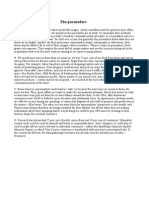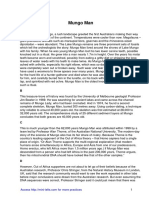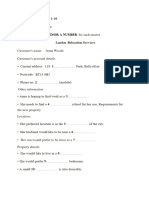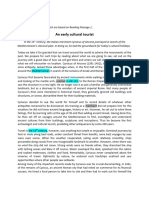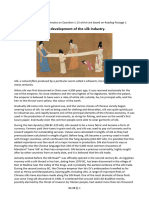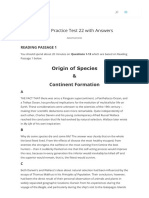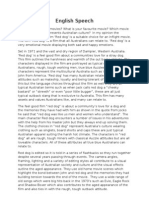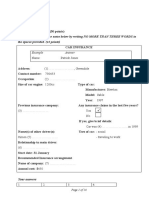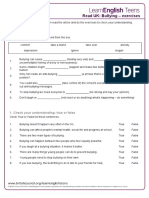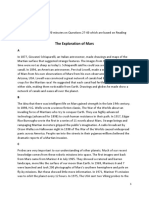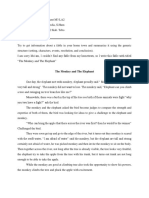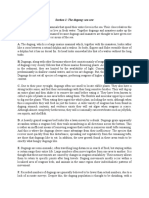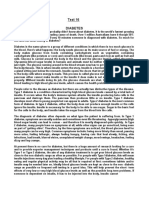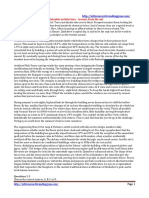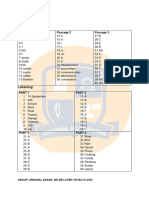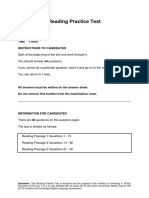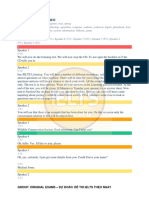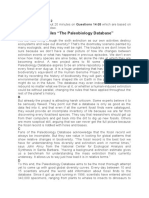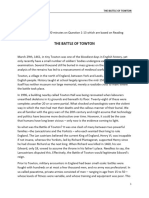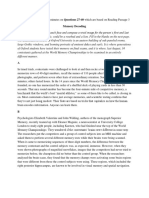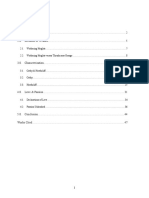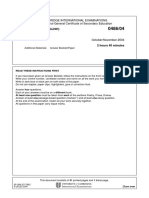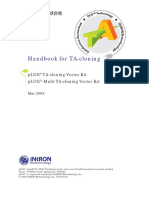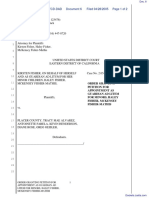Ielts 15.9
Ielts 15.9
Uploaded by
ChâuNguyễnCopyright:
Available Formats
Ielts 15.9
Ielts 15.9
Uploaded by
ChâuNguyễnOriginal Description:
Original Title
Copyright
Available Formats
Share this document
Did you find this document useful?
Is this content inappropriate?
Copyright:
Available Formats
Ielts 15.9
Ielts 15.9
Uploaded by
ChâuNguyễnCopyright:
Available Formats
Mr.
ZenicNguyen
Tel: 0169. 489. 3232
www.facebook.com/IELTSstepbystep
Memory Decoding
ht
tp
s:
//
.fa
ce
b
oo
k
.c
o
m
/IE
LT
Ss
te
p
by
s
te
p
A.
Try this memory test: Study each face and compose a vivid image for the
persons first and last name. Rose Leo, for example, could be a rosebud and a lion.
Fill in the blanks on the next page. The Examinations School at Oxford University is
an austere building of oak-paneled rooms, large Gothic windows, and looming
portraits of eminent dukes and earls. It is where generations of Oxford students have
tested their memory on final exams, and it is where, last August, 34 contestants
gathered at the World Memory Championships to be examined in an entirely different
manner. In timed trials, contestants were challenged to look at and then recite a twopage poem, memorize rows of 40-digit numbers, recall the names of 110 people after
looking at their photographs, and perform seven other feats of extraordinary
retention. Some tests took just a few minutes; others lasted hours. In the 14 years
since the World Memory Championships was founded, no one has memorized the
order of a shuffled deck of playing cards in less than 30 seconds. That nice round
number has become the four-minute mile of competitive memory; a benchmark that
the worlds best mental athletes, as some of them like to be called, are closing in
on. Most contestants claim to have just average memories, and scientific testing
confirms that theyre not just being modest. Their feats are based on tricks that
capitalize on how the human brain encodes information. Anyone can learn them.
B.
Psychologists Elizabeth Valentine and John Wilding, authors of the
monograph Superior Memory, recently teamed up with Eleanor Maguire, a
neuroscientist at University College London to study eight people, including Karsten,
who had finished near the top of the World Memory Championships. They wondered
if the contestants brains were different in some way. The researchers put the
competitors and a group of control subjects into an MRI machine and asked them to
perform several different memory tests while their brains were being scanned. When
it came to memorizing sequences of three-digit numbers, the difference between the
memory contestants and the control subjects was, as expected, immense. However,
when they were shown photographs of magnified snowflakes, images that the
competitors had never tried to memorize before, the champions did no better than the
control group. When the researchers analyzed the brain scans, they found that the
memory champs were activating some brain regions that were different from those
the control subjects were using. These regions, which included the right posterior
hippocampus, are known to be involved in visual memory and spatial navigation.
C.
It might seem odd that the memory contestants would use to visual
imagery and spatial navigation to remember numbers, but the activity makes sense
1
Mr. ZenicNguyen
Tel: 0169. 489. 3232
www.facebook.com/IELTSstepbystep
Mr. ZenicNguyen
Tel: 0169. 489. 3232
www.facebook.com/IELTSstepbystep
ht
tp
s:
//
.fa
ce
b
oo
k
.c
o
m
/IE
LT
Ss
te
p
by
s
te
p
when their techniques are revealed. Cooke, a 23-year-old cognitive-science graduate
student with a shoulder-length mop of curly hair, is a grand master of brain storage.
He can memorize the order of 10 decks of playing cards in less than an hour or one
deck of cards in less than a minute. He is closing in on the 30-second deck. In the
Lamb and Flag, Cooke pulled out a deck of cards and shuffled it. He held up three
cards the 7 of spades, the queen of clubs, and the 10 of spades. He pointed at a
fireplace and said. Destinys Child is whacking Franz Schubert with handbags. The
next three cards were the king of hearts, the king of spades, and the jack of clubs. He
ran over to the bar and announced, Admiral Lord Nelson is holding a guitar upside
down over there. By now, everyone in the pub had begun to gawk. Forty-six cards
and a few minutes later, Cooke ended up outside the Lamb and Flag, where he
proceeded to reel off the decks order flawlessly.
D.
How did he do it? Cooke has already memorized a specific person, verb,
and object that he associates with each card in the deck. For example, for the 7 of
spades, the person (or, in this case, persons) is always the singing group Destinys
Child, the action is surviving a storm, and the image is a dinghy. The queen of clubs
is always his friend Henrietta, the action is thwacking with a handbag, and the image
is of wardrobes filled with designer clothes. When Cooke commits a deck to memory,
he does it three cards at a time. Every three-card group forms a single image of a
person doing something to an object. The first card in the triplet becomes the person,
the second the verb, the third the object. He then places those images along a specific
familiar route, such as the one he took through the Lamb and Flag. In competitions,
he uses an imaginary route that He has designed to be as smooth and downhill as
possible. When it comes time to recall, Cooke takes a mental walk along his route
and translates the images into cards. Thats why the MRIs of the memory contestants
showed activation in the brain areas associated with visual imagery and spatial
navigation.
E.
The more resonant the images are, the more difficult they are to forget.
But even meaningful information is hard to remember when theres a lot of it. Thats
why competitive memorizers place their images along an imaginary route. That
technique, known as the loci method, reportedly originated in 477 B.C. with the
Greek poet Simonides of Ceos. Simonides was the sole survivor of a roof collapse
that killed all the other guests at a royal banquet. The bodies were mangled beyond
recognition, but Simonides was able to reconstruct the guest list by closing his eyes
and recalling each individual around the dinner table. What he had discovered was
that our brains are exceptionally good at remembering images and spatial
information. Evolutionary psychologists have offered an explanation: Presumably our
2
Mr. ZenicNguyen
Tel: 0169. 489. 3232
www.facebook.com/IELTSstepbystep
Mr. ZenicNguyen
Tel: 0169. 489. 3232
www.facebook.com/IELTSstepbystep
ht
tp
s:
//
.fa
ce
b
oo
k
.c
o
m
/IE
LT
Ss
te
p
by
s
te
p
ancestors found it important to recall where they found their last meal or the way
back to the cave. After Simonides discovery, the loci method popular across ancient
Greece as a trick for memorizing speeches and texts. Aristotle wrote about it, and
later a number of treatises on the art memory were published in Rome. Before printed
books, the art of memory was considered a staple or classical education on a par with
grammar, logic and rhetoric.
F.
The most famous of the naturals was the Russian journalist S. V.
Shereshevski, who could recall long lists of numbers memorized decades earlier, as
well as poems, strings of nonsense syllables, and just about anything else he was
asked to remember. The capacity of his memory had no distinct limits. wrote
Alexander Luria, the Russian psychologist who studied Shereshevski from the 1920s
to the 1950s. Shereshevski also had synesthesia, a rare condition in which the senses
become intertwined. For example, every number may be associated with a color or
every word with a taste. Synesthetic reactions evoke a response in more areas of the
brain, making memory easier. They also create problems. If I read when I eat, I have
a hard time understanding what Im reading the taste of the food drowns out the
sense. Shereshevski told Luria.
G.
K. Anders Ericsson, a Swedish-born psychologist at Florida State
University, thinks anyone can acquire Shereshevskis skills. He cites an experiment
with S. F., an undergraduate who was paid to take a standard test of memory called
the digit span for one hour a day, two or three days a week. When he started, he could
hold, like most people, only about seven digits in his head at any given time
(conveniently, the length of a phone number). Over two years, S.F. completed 250
hours of testing. By then, he had stretched his digit span from 7 to more than 80. He
had developed his own strategy for remembering based on his own experience as a
competitive runner: He associated strings of random numbers with track times. For
example 3,492 was remembered as 3 minutes and 49 point 2 seconds, near worldrecord mile time. The study of S. F. led Ericsson to believe that innately superior
memory doesnt exist at all. When he reviewed original case studies of naturals, he
found that exceptional memorizers were using techniques sometimes without
realizing it and lots of practice. Often, exceptional memory was only for a single
type of material, like digits. If we look at some of these memory tasks, theyre the
kind of thing most people dont even waste one hour practicing, but if they wasted 50
hours, theyd be exceptional at it, Ericsson says. It would be remarkable, he adds, to
find a person who is exceptional across a number of tasks. I dont think that theres
any compelling evidence that there are such people.
3
Mr. ZenicNguyen
Tel: 0169. 489. 3232
www.facebook.com/IELTSstepbystep
Mr. ZenicNguyen
Tel: 0169. 489. 3232
www.facebook.com/IELTSstepbystep
Questions 27-30
The reading Passage has seven paragraphs A-G.
Which paragraph contains the following information?
Write the correct letter A-G in boxes 27-30 on your answer sheet.
NB You may use any letter more than once.
The reason why competence of super memory is significant in academic
28
orders.
An example of extraordinary recalling by applying designed images
27
settings
Scientific experiment into Biological explanation for good memory
30
A depiction of natural ability of memory
te
p
by
s
te
p
29
Ss
Questions 31-35
.c
o
m
/IE
LT
Complete the following summary of the paragraphs of Reading Passage, using
NO MORE THAN THREE WORDS from the Reading Passage for each answer.
Write your answers in boxes 31-35 on your answer sheet.
ht
tp
s:
//
.fa
ce
b
oo
k
In World Memory Championships, 31 ___________ was a limitation time for
participants to remember a deck of cards. A man called Ed Cooke in a pub, spoke a
string of odd words when he held 7 of the spades (one of the three cards) was
remembered as he encoded it to a 32 ___________. The superior memory skill can be
traced back to Ancient Greece, the strategy was called 33 ___________. Russian
journalist had a similar mental condition named 34 ___________ which combined
number with other senses, but Ericsson suggested that fantastic memory could be
achieved by numerous 35 ___________.
4
Mr. ZenicNguyen
Tel: 0169. 489. 3232
www.facebook.com/IELTSstepbystep
Mr. ZenicNguyen
Tel: 0169. 489. 3232
www.facebook.com/IELTSstepbystep
Questions 36-40
Do the following statements agree with the information given in Reading
Passage 1?
In boxes 36-40 on your answer sheet, write
YES
if the statement is true
NO
if the statement is false
NOT GIVEN
if the information is not given in the passage
te
p
Cooke used a technique of connection with a real object and a number in
by
s
37
the card.
36
Two psychologists in Britain carried out an experiment which was open
to question
LT
Ss
te
p
38
Simonides recalled each dead guest by each unique sound which
belonged to every guest.
.c
o
m
/IE
39
Modern peoples memory largely dropped because of relying too much
on logic thinking.
ht
tp
s:
//
.fa
ce
b
oo
k
40
Ericsson gave his consent to the opinion of John Wilding and Eleanor
Maguire who did earlier experiment.
5
Mr. ZenicNguyen
Tel: 0169. 489. 3232
www.facebook.com/IELTSstepbystep
Mr. ZenicNguyen
Tel: 0169. 489. 3232
www.facebook.com/IELTSstepbystep
KEY
27. E
28. D
29. B
30. F
31. 30 seconds
32. specific person
33. loci method
te
p
34. synesthesia
by
s
35. practice
te
p
36. YES
LT
Ss
37. YES
m
/IE
38. NO
.c
o
39. NOT GIVEN
ht
tp
s:
//
.fa
ce
b
oo
k
40. NO
6
Mr. ZenicNguyen
Tel: 0169. 489. 3232
www.facebook.com/IELTSstepbystep
Mr. ZenicNguyen
Tel: 0169. 489. 3232
www.facebook.com/IELTSstepbystep
Mungo Man
ht
tp
s:
//
.fa
ce
b
oo
k
.c
o
m
/IE
LT
Ss
te
p
by
s
te
p
A.
Fifty thousand years ago, a lush landscape greeted the first Australians
making their way towards the south-east of the continent. Temperatures were cooler
than now. Megafauna - giant prehistoric animals such as marsupial lions, goannas and
the rhinoceros-sized diprotodon -were abundant. The Lake Mungo remains are three
prominent sets of fossils which tell the archeologists the story: Mungo Man lived
around the shores of Lake Mungo with his family. When he was young Mungo Man
lost his two lower canine teeth, possibly knocked out in a ritual. He grew into a man
nearly 1.7m in height. Over the years his molar teeth became worn and scratched,
possibly from eating a gritty diet or stripping the long leaves of water reeds with his
teeth to make twine. As Mungo Man grew older his bones ached with arthritis,
especially his right elbow, which was so damaged that bits of bone were completely
worn out or broken away. Such wear and tear is typical of people who have used a
woomera to throw spears over many years. Mungo Man reached a good age for the
hard life of a hunter-gatherer, and died when he was about 50. His family mourned
for him, and carefully buried him in the lunette, on his back with his hands crossed in
his lap, and sprinkled with red ochre. Mungo Man is the oldest known example in the
world of such a ritual.
B.
This treasure-trove of history was found by the University of Melbourne
geologist Professor Jim Bowler in 1969. He was searching for ancient lakes and came
across the charred remains of Mungo Lady, who had been cremated. And in 1974, he
found a second complete skeleton, Mungo Man, buried 300 meters away. Using
carbon-dating, a technique only reliable to around 40,000 years old, the skeleton was
first estimated at 28,000 to 32,000 years old. The comprehensive study of 25 different
sediment layers at Mungo concludes that both graves are 40,000 years old.
C.
This is much younger than the 62,000 years Mungo Man was attributed
with in 1999 by a team led by Professor Alan Thorne, of the Australian National
University. The modern day story of the science of Mungo also has its fair share of
rivalry. Because Thorne is the countrys leading opponent of the Out of Africa theory
-that Homo sapiens had a single place of origin. Dr. Alan Thorne supports the multiregional explanation (that modern humans arose simultaneously in Africa, Europe
and Asia from one of our predecessors, Homo erectus, who left Africa more than 1.5
million years ago.) if Mungo Man was descended from a person who had left Africa
in the past 200,000 years, Thorne argues, then his mitochondrial DNA should have
looked like that of the other samples.
D.
However, Out of Africa supporters are not about to let go of their beliefs
7
Mr. ZenicNguyen
Tel: 0169. 489. 3232
www.facebook.com/IELTSstepbystep
Mr. ZenicNguyen
Tel: 0169. 489. 3232
www.facebook.com/IELTSstepbystep
ht
tp
s:
//
.fa
ce
b
oo
k
.c
o
m
/IE
LT
Ss
te
p
by
s
te
p
because of the Australian research, Professor Chris Stringer, from the Natural History
Museum in London, UK, said that the research community would want to see the
work repeated in other labs before major conclusions were drawn from the Australian
research. But even assuming the DNA sequences were correct, Professor Stringer said
it could just mean that there was much more genetic diversity in the past than was
previously realized. There is no evidence here that the ancestry of these Australian
fossils goes back a million or two million years. Its much more likely that modern
humans came out of Africa. For Bowler, these debates are irritating speculative
distractions from the studys main findings. At 40,000 years old, Mungo Man and
Mungo Lady remain Australias oldest human burials and the earliest evidence on
Earth of cultural sophistication, he says. Modern humans had not even reached North
America by this time. In 1997, Pddbos research group recovered a mtDNA
fingerprint from the Feldholer Neanderthal skeleton uncovered in Germany in 1865the first Neanderthal remains ever found.
E.
In its 1999 study, Thornes team used three techniques to date Mungo
Man at 62,000 years old, and it stands by its figures. It dated bone, teeth enamel and
some sand. Bowler has strongly challenged the results ever since. Dating human
bones is notoriously unreliable, he says. As well, the sand sample Thornes group
dated was taken hundreds of meters from the burial site. You dont have to be a
gravedigger ... to realize the age of the sand is not the same as the age of the grave,
says Bowler.
F.
Thorne counters that Bowlers team used one dating technique, while his
used three. Best practice is to have at least two methods produce the same result. A
Thorne team member, Professor Rainer Grun, says the fact that the latest results were
consistent between laboratories doesnt mean they are absolutely correct. We now
have two data sets that are contradictory. I do not have a plausible explanation.
Now, however, Thorne says the age of Mungo Man is irrelevant to this origins debate.
Recent fossils finds show modern humans were in China 110,000 years ago. So he
has got a long time to turn up in Australia. It doesnt matter if he is 40,000 or 60,000
years old.
G.
Dr. Tim Flannery, a proponent of the controversial theory that Australias
megafauna was wiped out 46,000 years ago in a blitzkrieg of hunting by the
arriving people, also claims the new Mungo dates support this view. In 2001 a
member of Bowlers team, Dr. Richard Roberts of Wollongong University, along with
Flannery, director of the South Australian Museum, published research on their
blitzkrieg theory. They dated 28 sites across the continent, arguing their analysis
showed the megafauna died out suddenly 46,000 years ago. Flannery praises the
8
Mr. ZenicNguyen
Tel: 0169. 489. 3232
www.facebook.com/IELTSstepbystep
Mr. ZenicNguyen
Tel: 0169. 489. 3232
www.facebook.com/IELTSstepbystep
ht
tp
s:
//
.fa
ce
b
oo
k
.c
o
m
/IE
LT
Ss
te
p
by
s
te
p
Bowler teams research on Mungo Man as the most thorough and rigorous dating
of ancient human remains. He says the finding that humans arrived at Lake Mungo
between 46,000 and 50,000 years ago was a critical time in Australias history. There
is no evidence of a dramatic climatic change then, he says. Its my view that humans
arrived and extinction took place in almost the same geological instant.
H.
Bowler, however, is skeptical of Flannerys theory and says the Mungo
study provides no definitive new evidence to support it. He argues that climate
change at 40,000 years ago was more intense than had been previously realized and
could have played a role in the megafaunas demise. To blame the earliest
Australians for their complete extinction is drawing along bow.
9
Mr. ZenicNguyen
Tel: 0169. 489. 3232
www.facebook.com/IELTSstepbystep
Mr. ZenicNguyen
Tel: 0169. 489. 3232
www.facebook.com/IELTSstepbystep
Questions 1-8
Use the information in the passage to match the people (listed A-F) with
opinions or deeds below. Write the appropriate letters A-F in boxes 1-8 on your
answer sheet.
Alan Thorne
Pddbo
Tim Flannery
Chris Stringer
Rainer Grun
te
p
by
s
Jim Bowler
te
p
NB you may use any letter more than once.
LT
Ss
1
He was searching for ancient lakes and came across the charred remains
of Mungo Lady, who had been cremated.
.c
o
m
/IE
2
Professor who hold a skeptical attitude towards reliability for DNA
analysis on some fossils.
ce
b
oo
k
3
Professor whose determination of the age of Mungo Man to be much
younger than the former result which is older than the 62,000 years .
.fa
4
determining the age of Mungo Man has little to do with controversy for
the origins of Australians.
tp
s:
//
5
research group who recovered a biological proof of first Neanderthal
found in Europe.
ht
6
a supporter of the idea that Australias megafauna was extinct due to the
hunting by the ancient human beings.
7
Instead of keep arguing a single source origin, multi-regional
explanation has been raised.
8
Climate change rather than prehistoric human activities resulted in
megafaunas extinction.
10
Mr. ZenicNguyen
Tel: 0169. 489. 3232
www.facebook.com/IELTSstepbystep
Mr. ZenicNguyen
Tel: 0169. 489. 3232
www.facebook.com/IELTSstepbystep
Questions 9-14
Do the following statements agree with the information given in Reading
Passage 1?
In boxes 9-14 on your answer sheet, write
TRUE
if the statement is true
FALSE
if the statement is false
NOT GIVEN
if the information is not given in the passage
te
p
In Lake Mungo remains, weapons were found used by the Mungo.
by
s
10
9
The Lake Mungo remains offer the archeologists the evidence of graphic
illustration of human activities around
Mungo man and womans skeletons were uncovered in the same year.
LT
12
Ss
te
p
11
Mungo Man is one of the oldest known archeological evidence in the
world of cultural sophistication such as a burying ritual.
.c
o
m
/IE
13
There is controversy among Scientists about the origin of the oldest
Homo sapiens.
ht
tp
s:
//
.fa
ce
b
oo
k
14
Out of Africa supporters have criticizes Australian professors for using
outmoded research method
11
Mr. ZenicNguyen
Tel: 0169. 489. 3232
www.facebook.com/IELTSstepbystep
Mr. ZenicNguyen
Tel: 0169. 489. 3232
www.facebook.com/IELTSstepbystep
KEY
1. A
2. E
3. A
4. B
5. C
6. D
7. B
te
p
8. A
by
s
9. TRUE
te
p
10. NOT GIVEN
LT
Ss
11. TRUE
m
/IE
12. FALSE
.c
o
13. TRUE
ht
tp
s:
//
.fa
ce
b
oo
k
14. NOT GIVEN
12
Mr. ZenicNguyen
Tel: 0169. 489. 3232
www.facebook.com/IELTSstepbystep
You might also like
- Matching SentencesDocument7 pagesMatching SentencesHiền Cao MinhNo ratings yet
- @mindless WriterDocument4 pages@mindless Writerjavohirakmalov2No ratings yet
- (Barash) Clinical Anesthesia (6th Ed.)Document3,968 pages(Barash) Clinical Anesthesia (6th Ed.)menocide_ss67% (3)
- Reading Passage 1: Succeed in IELTS Volume 11Document16 pagesReading Passage 1: Succeed in IELTS Volume 11Anonymous RPGElSNo ratings yet
- Real Exam PaperDocument4 pagesReal Exam PaperJoshua JethrohNo ratings yet
- Adjusting Entries Justin Park CASEDocument20 pagesAdjusting Entries Justin Park CASEDKzNo ratings yet
- Book Data Fats That Heal Fats That KillDocument5 pagesBook Data Fats That Heal Fats That Killnandoperu33% (3)
- Mungo ManDocument5 pagesMungo ManTactics HerosNo ratings yet
- Mocktest 3 ReadliswrtDocument19 pagesMocktest 3 ReadliswrtĐức TrungNo ratings yet
- Se Reading Vol 3Document112 pagesSe Reading Vol 3My NguyễnNo ratings yet
- Reading IELTS Vol 2 Test 1Document11 pagesReading IELTS Vol 2 Test 1Minh TàiNo ratings yet
- How To Find Your Way Out of A Food DesertDocument5 pagesHow To Find Your Way Out of A Food DesertGiang TrinhNo ratings yet
- Academic Reading: All Answers Must Be Written On The Answer SheetDocument21 pagesAcademic Reading: All Answers Must Be Written On The Answer SheetLemon MahamudNo ratings yet
- Oddball QuestionsDocument2 pagesOddball QuestionsSara JaswalNo ratings yet
- Northeast Africa. It Is Unknown What The People of ThisDocument12 pagesNortheast Africa. It Is Unknown What The People of Thisapi-318798714100% (1)
- Reading PracticeDocument3 pagesReading PracticeUyên Hoàng100% (1)
- Passage 1: The Development of The Silk IndustryDocument10 pagesPassage 1: The Development of The Silk IndustryNgoc Anh NguyenNo ratings yet
- Bản Sao Của Bản Sao Của Passage 1 1Document16 pagesBản Sao Của Bản Sao Của Passage 1 1Luu Hong NhiNo ratings yet
- IELTS Reading Practice Test Raining OnlineDocument16 pagesIELTS Reading Practice Test Raining Onlinebhiman bajarNo ratings yet
- English SpeechDocument2 pagesEnglish SpeechBryce1998No ratings yet
- Ielts Reading Test 15Document9 pagesIelts Reading Test 15Sahil RandhawaNo ratings yet
- Section 1 Questions 1-13Document13 pagesSection 1 Questions 1-13ielts Ice GiangNo ratings yet
- MS-HSS-AC-Unit 3 - Chapter 6 - Ancient India PDFDocument40 pagesMS-HSS-AC-Unit 3 - Chapter 6 - Ancient India PDFkyla100% (1)
- 22 Passage 2 - Western Immigration of Canada Q14-26Document6 pages22 Passage 2 - Western Immigration of Canada Q14-26Cương Nguyễn DuyNo ratings yet
- 104 Passage 2 - A New Look For Talbot ParkDocument4 pages104 Passage 2 - A New Look For Talbot ParkThy HuynhNo ratings yet
- Mock Test 5: Question 1: Complete The Notes Below by Writing NO MORE THAN THREE WORDS in The Spaces Provided. (14 Points)Document16 pagesMock Test 5: Question 1: Complete The Notes Below by Writing NO MORE THAN THREE WORDS in The Spaces Provided. (14 Points)Châu DươngNo ratings yet
- Read UK: Bullying - Exercises: PreparationDocument2 pagesRead UK: Bullying - Exercises: PreparationsttomsNo ratings yet
- 07 Passage 3 - Learning Lessons From The Past Q27-40Document6 pages07 Passage 3 - Learning Lessons From The Past Q27-40Cương Nguyễn DuyNo ratings yet
- 17 Passage 3 - The Exploration of Mars Q27-40Document7 pages17 Passage 3 - The Exploration of Mars Q27-40Cương Nguyễn DuyNo ratings yet
- The Monkey and The ElephantDocument2 pagesThe Monkey and The ElephantBurhanNo ratings yet
- Section 1: The Dugong: Sea CowDocument11 pagesSection 1: The Dugong: Sea CowKelvin100% (1)
- Reading Passage 3-20.5Document5 pagesReading Passage 3-20.5JaydenNo ratings yet
- Film Studies JasmineDocument13 pagesFilm Studies Jasminebarbarafc kuninganNo ratings yet
- 08 Passage 1 - Otter Q1-13Document5 pages08 Passage 1 - Otter Q1-13Cương Nguyễn DuyNo ratings yet
- Ielts Reading Test 10 - PassagesDocument9 pagesIelts Reading Test 10 - PassagesĐinh Quốc LiêmNo ratings yet
- Reading Passage 1Document4 pagesReading Passage 1Hiền Cao MinhNo ratings yet
- Reading Passage 1: Test 16 DiabetesDocument7 pagesReading Passage 1: Test 16 DiabetesRavi ZaiminNo ratings yet
- IELTS Reading Practice 2Document9 pagesIELTS Reading Practice 2nhung phanNo ratings yet
- Ielts Reading Test 12Document6 pagesIelts Reading Test 12Nur IndahNo ratings yet
- Enola HolmesDocument2 pagesEnola Holmessofiacagiao97No ratings yet
- Enola Holmes FinalDocument2 pagesEnola Holmes FinalSara JaswalNo ratings yet
- Explanation - 8Document3 pagesExplanation - 8Gia Huy NguyenNo ratings yet
- 20 Elements of Periodic TableDocument5 pages20 Elements of Periodic TableAila Janella ValdezNo ratings yet
- Academic Reading IeltsDocument11 pagesAcademic Reading IeltsFoukaltsFatherNo ratings yet
- Authentic Reading Test Collections Volume 5Document101 pagesAuthentic Reading Test Collections Volume 5Thanh Xuân100% (7)
- KEY PDFDVDDDocument2 pagesKEY PDFDVDDMarufNo ratings yet
- Views Concerning The Ethics of Advertising Aimed at Children Diverge Widely in EuropeDocument6 pagesViews Concerning The Ethics of Advertising Aimed at Children Diverge Widely in EuropeMohannad FAlhNo ratings yet
- Ielts Reading Test 15Document6 pagesIelts Reading Test 15Nur IndahNo ratings yet
- Reading Practice Test v5Document14 pagesReading Practice Test v5hachanNo ratings yet
- Summary Keywords: Group: Original Exams - Dự Đoán Đề Thi Ielts Theo NgàyDocument10 pagesSummary Keywords: Group: Original Exams - Dự Đoán Đề Thi Ielts Theo Ngày45.thiên ýNo ratings yet
- PRE Test ReadingDocument10 pagesPRE Test ReadingAnak komunikasi BangetNo ratings yet
- Why Does Skin Wrinkle in WaterDocument13 pagesWhy Does Skin Wrinkle in Wateri CAN50% (2)
- Fossil Files "The Paleobiology Database": Reading Passage 2Document4 pagesFossil Files "The Paleobiology Database": Reading Passage 2Nguyễn Trần Khánh LinhNo ratings yet
- Reading Test 2Document11 pagesReading Test 2Le Thien AnNo ratings yet
- 70 Passage 1 - The Battle of Towton q1-13Document5 pages70 Passage 1 - The Battle of Towton q1-13karan020419No ratings yet
- Readingpracticetest2 v9 1532601Document15 pagesReadingpracticetest2 v9 1532601Rajinder Singh KahlonNo ratings yet
- Test 3Document5 pagesTest 3721k0060No ratings yet
- IELTS Reading Practice Test 24Document17 pagesIELTS Reading Practice Test 24Nguyễn LinhNo ratings yet
- Academic IELTS Reading Test 168Document10 pagesAcademic IELTS Reading Test 168Alptekin TalancıNo ratings yet
- Passage 3 - Đề thi gốc ngày 3.3.2022Document5 pagesPassage 3 - Đề thi gốc ngày 3.3.2022Yến Nhi100% (1)
- Hybrid & Electric Cars in Norway: October 2016Document40 pagesHybrid & Electric Cars in Norway: October 2016ChâuNguyễnNo ratings yet
- OthelloDocument38 pagesOthelloChâuNguyễn100% (1)
- OthelloDocument49 pagesOthelloChâuNguyễnNo ratings yet
- OthelloDocument2 pagesOthelloChâuNguyễn0% (1)
- Energy Pastways: Issues of Transporting Energy Resources.: The Alaskan Oil PipelineDocument1 pageEnergy Pastways: Issues of Transporting Energy Resources.: The Alaskan Oil PipelineChâuNguyễnNo ratings yet
- Band 8 Toàn ZIM: Historical BackgroundsDocument11 pagesBand 8 Toàn ZIM: Historical BackgroundsChâuNguyễn100% (1)
- Past PaperDocument32 pagesPast PaperChâuNguyễnNo ratings yet
- All My Sons NoteDocument4 pagesAll My Sons NoteChâuNguyễn100% (1)
- Warings Symbolism Setting (Chapter 1)Document6 pagesWarings Symbolism Setting (Chapter 1)ChâuNguyễnNo ratings yet
- Etheno-Medicinal Plant of Saputara Hill, Dang District, GujaratDocument7 pagesEtheno-Medicinal Plant of Saputara Hill, Dang District, GujaratSAKARIYA PRARTHNANo ratings yet
- RISK ASSESSMENT QUIZ ANSWERS (Confer)Document1 pageRISK ASSESSMENT QUIZ ANSWERS (Confer)Roh Young songNo ratings yet
- Sop 2001Document6 pagesSop 2001fedly100% (1)
- Ottocoll® P83: The PU Adhesive/sealantDocument3 pagesOttocoll® P83: The PU Adhesive/sealantJoeNo ratings yet
- Gingival Retraction Techniques: A Review: Dental Update April 2018Document10 pagesGingival Retraction Techniques: A Review: Dental Update April 2018Varun bharathiNo ratings yet
- User Manual NapoliDocument44 pagesUser Manual NapoliAhmed saNo ratings yet
- Electronic 5S: An Introduction To Digital Workplace OrganizationDocument32 pagesElectronic 5S: An Introduction To Digital Workplace Organizationjemal yahyaaNo ratings yet
- Home Economics-Bread and Pastry ProductionDocument6 pagesHome Economics-Bread and Pastry ProductionJuan L. CruzNo ratings yet
- The Effectiveness of A Learning Strategies Program For University StudentsDocument6 pagesThe Effectiveness of A Learning Strategies Program For University StudentsAngelica PinedaNo ratings yet
- Tpe Chemical ResistanceDocument12 pagesTpe Chemical ResistanceBrijesh GajjarNo ratings yet
- Menu Menu PlanningDocument27 pagesMenu Menu Planningesther jusephNo ratings yet
- Antimalarial DrugsDocument49 pagesAntimalarial DrugsMalueth Angui50% (2)
- Term 2 - Grade 8 Science Chapter 6 Conservation of Plants and AnimalsDocument3 pagesTerm 2 - Grade 8 Science Chapter 6 Conservation of Plants and Animalsris.aryajoshiNo ratings yet
- Session4-5 Rajesh - Jha - Coal Gasification & SynGas Based DRI - PPT - 5Document45 pagesSession4-5 Rajesh - Jha - Coal Gasification & SynGas Based DRI - PPT - 5telegenicsNo ratings yet
- Studi Efek Iradiasi Radium Untuk Pengolahan Limbah Sianida Industri An EmasDocument17 pagesStudi Efek Iradiasi Radium Untuk Pengolahan Limbah Sianida Industri An EmasMuhammad Sadiqul Iman100% (1)
- Front and Back Wraparound Labeler - Tronics Series 3 Premier Labeling System Brochure, CatalogDocument8 pagesFront and Back Wraparound Labeler - Tronics Series 3 Premier Labeling System Brochure, CatalogtronicsamericaNo ratings yet
- Microbial Ecology and Starter Culture Technology in Coffee ProcessingDocument15 pagesMicrobial Ecology and Starter Culture Technology in Coffee ProcessingLael IsazaNo ratings yet
- ER 04-SoS Standard For Electricity Distribution System v3Document30 pagesER 04-SoS Standard For Electricity Distribution System v3abdur.rehmanNo ratings yet
- MS For Sewer Line Road CrossingDocument10 pagesMS For Sewer Line Road CrossingSarfraz Randhawa100% (1)
- 07 - Dual-Phase Stimulated Raman Scattering Microscopy For Real-Time Two-Color ImagingDocument4 pages07 - Dual-Phase Stimulated Raman Scattering Microscopy For Real-Time Two-Color Imagingyoussef ahmadNo ratings yet
- Handbook For TA CloningDocument24 pagesHandbook For TA CloningAmrizal MuchtarNo ratings yet
- DocumentDocument5 pagesDocumentSalma begamNo ratings yet
- Acme Laboratories Ltd. - Unsolicited-PtdDocument13 pagesAcme Laboratories Ltd. - Unsolicited-PtdnasirNo ratings yet
- SHP Safety Walk Arounds For ManagersDocument2 pagesSHP Safety Walk Arounds For ManagersIoana UrsanNo ratings yet
- Class Standing 2Document11 pagesClass Standing 2Sofia Mae FaeldoniaNo ratings yet
- PFI-ES-05 (Cleaning 2006) PDFDocument2 pagesPFI-ES-05 (Cleaning 2006) PDFRamesh Kumar RamisettiNo ratings yet
- Fisher Et Al v. Placer County, Et Al. - Document No. 6Document2 pagesFisher Et Al v. Placer County, Et Al. - Document No. 6Justia.comNo ratings yet
- 紅寶ListDocument66 pages紅寶ListEden ChengNo ratings yet




